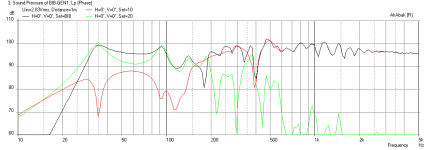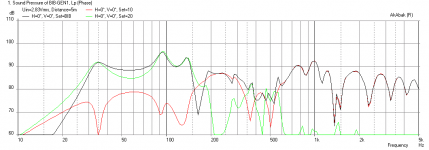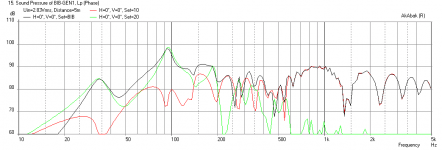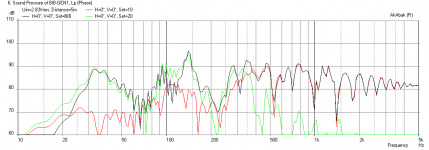It will affect it, but you'll need to sim it in MJK's software to see how it is affected by the room. FWIW, a long time ago, he suggested moving it down to 0.434*L for 'subs', so a position to consider.
Consider too that a max flat alignment for this driver is around a 67.29 Fb, or a ~100" path-length BIB if inputted as Fs, shifting the driver down to ~21.7", so if you can tolerate the extra height and willing to gamble some time/wood...........
GM
Consider too that a max flat alignment for this driver is around a 67.29 Fb, or a ~100" path-length BIB if inputted as Fs, shifting the driver down to ~21.7", so if you can tolerate the extra height and willing to gamble some time/wood...........
GM
Model of Generalized BIB with Room Placement
I have a generalized model of a BIB in AkAbak where I just input the Width x Depth x Height and driver T/S parameters and it lets me look at the effect of placement near or away from a wall. As a test case, I tried the Betsy K in a BIB which for some reason, I do not ever recall anyone trying out. If you have measurements to compare that would be great.
The simulations are with the BIB mounted flush against a wall with mic at 1 m (first plot), then 5 m away (second plot). Now place the BIB 60 in away from a back wall with listening position 5 m away (third plot). Notice that the response is very uneven when not assisted by wall-loading.
If you put the BIB 60 in away from either wall in a corner and stand 5 meters away it helps to restore some of the low end bass extension that was lost from the above case, but you get a response that has holes at 70 Hz and 220 Hz, and general uneven response (fourth plot).
The case of 1 m away flush against a wall looks very good but as one starts to move away from speaker, the response degrades. Nonetheless, the BIB still has a decent response for such a simple design.
I have a generalized model of a BIB in AkAbak where I just input the Width x Depth x Height and driver T/S parameters and it lets me look at the effect of placement near or away from a wall. As a test case, I tried the Betsy K in a BIB which for some reason, I do not ever recall anyone trying out. If you have measurements to compare that would be great.
The simulations are with the BIB mounted flush against a wall with mic at 1 m (first plot), then 5 m away (second plot). Now place the BIB 60 in away from a back wall with listening position 5 m away (third plot). Notice that the response is very uneven when not assisted by wall-loading.
If you put the BIB 60 in away from either wall in a corner and stand 5 meters away it helps to restore some of the low end bass extension that was lost from the above case, but you get a response that has holes at 70 Hz and 220 Hz, and general uneven response (fourth plot).
The case of 1 m away flush against a wall looks very good but as one starts to move away from speaker, the response degrades. Nonetheless, the BIB still has a decent response for such a simple design.
Attachments
I'd say with a driver with those specs, don't put it on the wall and don't put it in a BIB of any kind.
It looks to be very directive and with a soft top, so unless assisted by a tweeter, you need to toe in.
The Qts is quite high and so is the FS for a driver this size, so I'd say some kind of transmission line would be good. Maybe a big TABAQ?
It looks to be very directive and with a soft top, so unless assisted by a tweeter, you need to toe in.
The Qts is quite high and so is the FS for a driver this size, so I'd say some kind of transmission line would be good. Maybe a big TABAQ?
The case of 1 m away flush against a wall looks very good but as one starts to move away from speaker, the response degrades. Nonetheless, the BIB still has a decent response for such a simple design.
From here: http://www.diyaudio.com/forums/full-range/237948-speaker-kicks-butt-large-spaces.html#post3534062
Hmm, many folk's listening experiences and occasional measurements don't line up hardly at all with these or other long distance sims you've posted, so I'm inclined to ignore all of the room modes BW of those more than a meter away.........
For sure, I wouldn't use them for tweaking a design.
GM
I have a generalized model of a BIB in AkAbak where I just input the Width x Depth x Height and driver T/S parameters and it lets me look at the effect of placement near or away from a wall. As a test case, I tried the Betsy K in a BIB which for some reason, I do not ever recall anyone trying out. If you have measurements to compare that would be great.
The simulations are with the BIB mounted flush against a wall with mic at 1 m (first plot), then 5 m away (second plot). Now place the BIB 60 in away from a back wall with listening position 5 m away (third plot). Notice that the response is very uneven when not assisted by wall-loading.
If you put the BIB 60 in away from either wall in a corner and stand 5 meters away it helps to restore some of the low end bass extension that was lost from the above case, but you get a response that has holes at 70 Hz and 220 Hz, and general uneven response (fourth plot).
The case of 1 m away flush against a wall looks very good but as one starts to move away from speaker, the response degrades. Nonetheless, the BIB still has a decent response for such a simple design.
Is that taking into account the ceiling with the BIB, when away from the wall?
Hmm, the BIB is a TL, which as you imply is best suited for high Qts drivers, so why the seeming contradiction?
GM
It's a horn! ;-) Of course almost everything in audio is rather fluid, but I'd say that a BiB is mostly a horn. Why else would all those low Qts Fostex drivers work so well in them? It's expanding and has compression in the throat area. In my book that makes it a tapped horn.
Is that taking into account the ceiling with the BIB, when away from the wall?
I don't have a way to simulate a ceiling unless the the floor is left off. There is a way to do a wall and floor or ceiling and floor, or two walls and ceiling in corner. But not a floor and a ceiling far away from walls. So having a ceiling will certainly improve the bass away from walls for a tall BIB.
It's a horn! ;-) Of course almost everything in audio is rather fluid, but I'd say that a BiB is mostly a horn. Why else would all those low Qts Fostex drivers work so well in them? It's expanding and has compression in the throat area. In my book that makes it a tapped horn.
In my experience, a BIB works well with low or moderately high circa 0.9 (not super high) Qts drivers. It is almost as universal as an enclosure can get.
A horn is an expanding TL, a restricted terminus horn is a mass loaded tapered TL, there is no distinction in AkAbak - they are all waveguides.
It's a horn!
Acoustically, it's a waveguide since it's a parabolic expansion and why pretty much anything works in them, at least in a sim up to a 2.56 Qts, though of course a really high Qts would make it unacceptably large if the BIB calculator is used [~75.13 ft^3 Vs the sim's ~6.13 ft^3].
This one is tuned to ~reactance annul the driver's impedance at Fs [AKA max flat impedance TL].
GM
Attachments
Well, it seems to boil down to semantics. High Qts BIBs (which have very different dimensions from low) could very well be said to work more as TLs or waveguides. Vis a vis the drawing from the last page.
I still would venture that a constrained opening/narrowing TL would be a better choice for the driver in question?
I still would venture that a constrained opening/narrowing TL would be a better choice for the driver in question?
Last edited:
We know Betsy K works well in MLTL - see WIBAQ thread. I was just asking question why we haven't see one in a BIB considering folks have done it with other 8 in full range drivers like the Pioneer BOFU or Visaton BG20, which result in rather large BIB's. But as GM points out, the BIB enclosure is very forgiving and almost any Qts driver will work. The sim with the Betsy does show that it indeed works quite well, albeit the cabinet is huge. I am working on adapting the generalized BIB model to include a definable generalized Karlson aperture based on Aperture length, initial slot gap, and final opening width.
Well, it seems to boil down to semantics. High Qts BIBs (which have very different dimensions from low) could very well be said to work more as TLs or waveguides. Vis a vis the drawing from the last page.
I still would venture that a constrained opening/narrowing TL would be a better choice for the driver in question?
True, there's the equivalent electrical-mechanical definitions used to generate the acoustical ones and I prefer to further define them to make it clear as to what type of alignment/shape I'm referring to, but the folks who design using the higher math required can't be bothered, so there's normally much confusion on threads such as this one.
WRT to a TQWT being a better overall loading for high Qt systems, I view it this way……… a reflex with a long vent can be morphed into a TQWT [inverse taped] or truncated by mass loading it [ML-TQWT], so best suited to low Vas and/or low Qt systems whereas high Vas or high Qt systems require big cabs with a big vent area, so can be morphed into a pipe horn [expanding taper] or truncated by mass loading [ML-horn]. The middle range then is best suited to TL/MLTL.
Specific to the Betsy or any ‘FR’ driver for that matter, I’m inclined to always recommend/use either a [ML]TL or [ML]horn since the necessarily highly damped TQWT tends to over-damp the driver’s ability to generate sufficient inner detail beginning in the upper bass/critical lower mids.
Better IME to let the driver ‘sing’ and selectively damp any obnoxious resonances except for those drivers that ‘sing’ really loud and/or low such as some old RadioShack or similar car audio/ceiling PA drivers are wont to do.
In short, guess we’ll have to agree to disagree.
With MJK choosing to call both these expansion extremes the same and unwillingness to change for clarity’s sake combined with Voigt’s, Weems’ and others earlier published inconsistencies, each thread where TLs and/or horns are mentioned is normally a very confusing one, especially for a beginner.
GM
I was just asking question why we haven't see one in a BIB..........
Actually, 'wild burro' did one, though it was done pre-BIB calculator: http://www.diyaudio.com/forums/wild-burro-audio/156107-enclosure-designs-burro-speakers.html
Note that the 10:1 TQWT I did was designed for a specific app and only need a MLTL's or MLhorn's low stuffing density, so merely an exception to my general 'rule'.
GM
https://sites.google.com/site/speakerprojects/enclosures/bib
You can download the BIB Calculator from the above link. As I was experimenting with Google Sites I decided to create a project for myself. Everything is under construction so don't expect to find any content.
Zilla
You can download the BIB Calculator from the above link. As I was experimenting with Google Sites I decided to create a project for myself. Everything is under construction so don't expect to find any content.
Zilla
Has anyone ever built an in-wall BIB? The 16 in CTC spacing between studs behind drywall will allow you to fit a modified BIB where the top vent would be angled out - use a HVAC grill and it will look like part of the AC vent near the ceiling. The driver would be mounted right at ear level on the drywall. Very high WAF and takes no floor space and good for the media or HT room. Often with the HT room in the basement there is access on the backside of the drywall to put any speaker you want. If you don't have access you can go with a sideways flat BIB or FIB with a smaller driver and fit it in the 3.5 in cavity.
What a great idea, in-wall BIB! Honey, get my sledge hammer! lol
Larry
LOL.
Seriously, a keyhole saw to remove a panel of drywall and build the speaker and replace the panel you just cut with tape and spackling, roll on new paint and you are done! Use construction adhesive to glue the internal divider and bottom and tops (using 1/2 in thick x 3.5 in wide pine board). Cut hole in your rectangular BIB panel that you just cut out for the driver. Add stuffing and wires... She will never even know you did it other than the fact that the driver is on the wall. Now use one of those painted decorator interior speaker grill covers painted to match your wall.
modified BIB where the top vent would be angled out - use a HVAC grill and it will look like part of the AC vent near the ceiling.
This angling out would probably negate the effect of final expansion the corners (or ceiling-wall at least) have for the design, turning it into a kind of "hidden transmission line" enclosure. Not bad, per se, but probably without the bass extension that is characteristic of the design.
Gaston
I recall it being discussed a few times, but the low net Vb severely limits driver selection to the point where a high pass is required to protect the driver unless one or more studs are removed. Doing this in a load bearing wall is the best choice, but isn't a good plan unless some additional form of local code approved reinforcement is added.
While most have been sealed, there's been a few MLTLs and TQWTs over the decades, but no longer have any details at this late date.
GM
While most have been sealed, there's been a few MLTLs and TQWTs over the decades, but no longer have any details at this late date.
GM
- Home
- Loudspeakers
- Full Range
- Terry Cain's BIB -why does it work and does anyone have those Fostex Craft Handbooks?




![40-1271 pipe horn [GM design].gif](/community/data/attachments/324/324807-5c45c9c324058d77eee52e60e7d176fd.jpg)